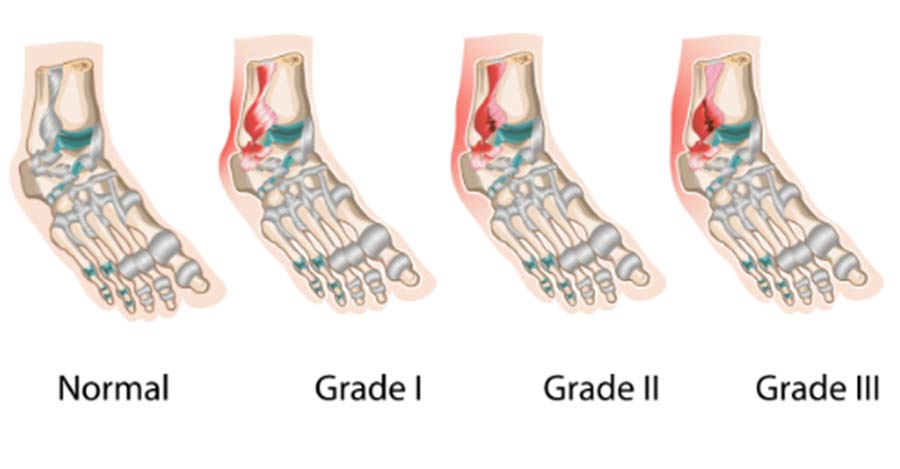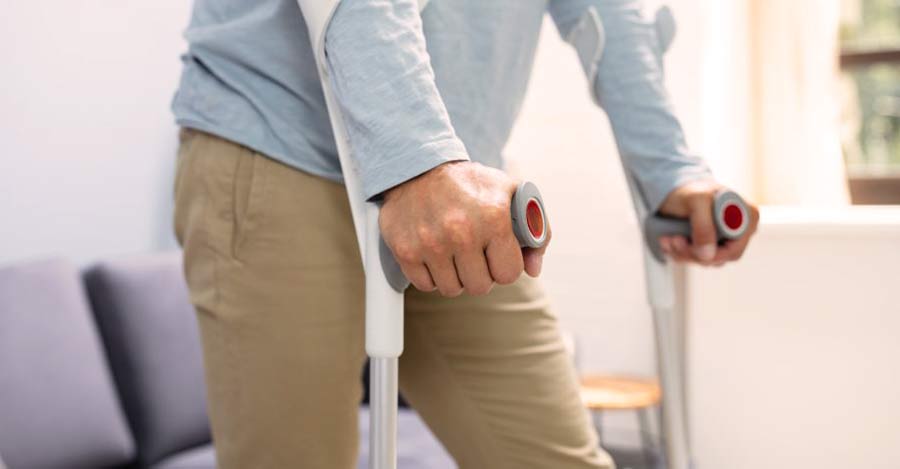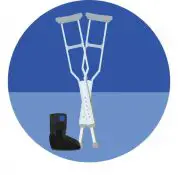Are crutches needed for a sprained ankle?
Think carefully. Do you feel you need crutches for a sprained ankle? This is a valid question to ask yourself if you have suffered a sprained ankle injury.
Within this article, we will discuss everything you should note. By the end of reading it, you can answer this question yourself.
What Are The Causes Of Sprained Ankles?

Before discussing the causes of a sprained ankle, we should first note what a sprained ankle is. Your ankle joint connects to your foot which then connects to your lower leg. For your ankle bones to stay in place, it is connected to three ligaments. A sprained ankle occurs when these ligaments in your foot are strained, stretched, or torn.
You should keep in mind that an ankle sprain generally occurs when a foot rolls, turns inward, or twists. These movements cause the ankle joint to shift out of its normal position.
Now that we know what a sprained ankle is, we can look at a few of the common causes below.
- Full contact or no contact sports that involve running. Running can cause an ankle sprain if you place your foot down wrong, get tackled, or twist the position of your feet.
- When you step on an uneven surface incorrectly. For example, if you step into a hole or off of a pavement wrong.
- Taking a fall or slipping on a wet surface or while climbing up a ladder or other outdoor equipment.
- Taking a heavy hit to the body that causes you to lose balance or shift your balance.
- A prior ankle injury can cause you to sprain your ankle again more easily.
- Wearing improper shoes that don’t fit correctly. Additionally, wearing shoes that aren’t right for the activity, you are doing.
Sprained Ankle Grade Classifications Symptoms And Diagnosed
When looking at your injury, it’s essential to identify the grade classification. Additionally, it’s also crucial to determine the symptoms of a sprained ankle.Moreover, you should know how a sprained ankle is diagnosed.
If you know this medical information, you can begin recovery procedures.
What Are The Symptoms Of A Sprained Ankle
As with most injuries, a sprained ankle injury symptoms will vary. Symptoms will depend on how severe the ailment is. Below are some of the more common symptoms those with sprained ankles have reported.

- Swelling around the ankle.
- Bruising around the ankle.
- A loud popping or snapping sound or sensation at the time of injury.
- Pain associated with placing weight or pressure on your ankle or foot.
- Inability to walk on the ankle or move it due to instability.
- A restricted range of motion when you try to move your ankle or foot.
- Discoloration around the ankle and stiffness.
How A Sprained Ankle is Diagnosed?
For a sprained ankle to be diagnosed, you will need to have experienced one before or visit a local doctor. Your doctor will analyze your sprained ankle by performing a physical exam.
When doing this exam, they will look for if you have any partially or fully torn ligaments. He or she will do this by moving your ankle joint in various directions.
Sometimes your doctor may need you to go for an MRI or X-ray to determine how severe your ankle has been sprained. By doing this, they can also rule out a bone fracture and ensure they provide you with the proper treatment.
The Three Grade Classifications Of A Sprained Ankle
Doctors have three grade classifications for those suffering from a sprained ankle. They will give a specific grade rating depending on the severity of your injury. If you have the grade classification, you will know what to do to hasten your healing time.
Below we have briefly listed the three different sprained ankle grade classifications. These will help you identify the severity of your injuries and help you figure out if you need crutches.

- Grade One: A grade one classification is given to those who have a mild sprained ankle injury. If your doctor classifies your sprain as a grade one, your ligaments are stretched but not torn. Your ankle will still feel stable. If you have a mild ankle sprain injury, you will likely feel some pain and stiffness but not much, if any, swelling.
- Grade Two: A grade two classification is given to those who have a moderate ankle sprain injury. With a grade two sprain, the ligaments will be partially torn. Your joint will be slightly unstable with a moderate ankle sprain. Additionally, you will experience pain and swelling.
- Grade Three: A grade three classification is given to those who have a severe ankle sprain injury. If you have a severe sprain injury, your doctor will advise you that one or more of your ligaments are torn. With a grade three classification, you won’t be able to move your joint as much as usual. It will be completely unstable. Additionally, there will also be swelling, pain and immovability.
Could You Injure Your Ankle Further If You Do Not Use Crutches?

If you have a serious grade two or three sprain, your doctor will likely tell you to use crutches. Crutches are a handy mobility aid. They truly help you recover faster as they keep your ankle safe and secure, and immobile. The less your ankle moves, the faster it will heal.
When you have a moderate or severe ankle sprain and you don’t use crutches, it could take longer for your injury to heal. Additionally, if you don’t use crutches, you could make your sprain worse. You could cause more swelling or injury by placing weight on the ankle.
For example, suppose you have a grade three sprain and have torn your ligaments and don’t use crutches. In that case, you could cause or worsen internal bleeding around the ankle.
Should You See A Doctor About A Sprained Ankle?

Some sprained ankle injuries don’t need you to visit a doctor. Yet, are you experiencing painful or abnormal swelling and discomfort in the ankle area? If you are, it could be a serious sprain, and you should get in touch with a doctor.
Your doctor might only prescribe rest and self-care. Or they may prescribe crutches, but it’s better to be on the safe side. If you leave the sprain and continue to put pressure on it, you could end up causing irreparable damage. Damage that would affect the ligaments and possibly cause severe internal bleeding. Additionally, see your doctor about your ankle sprain if you experience the below.
- You can’t walk or move your ankle or have severe pain when you do.
- If your sprained ankle does not get better within five to seven days.
- Your pain is so severe that it does not get better, even after taking over-the-counter medication.
What To Do Before Seeing Your Trusted Physical Therapist
Before seeing your physical therapist, you should follow the “Price” method. If you follow this method for at least 48 hours, you will know if you have a more severe ankle sprain injury.
- Protection: You need to protect and immobilize the ankle that is sprained. You can do this by making sure you keep your weight off your ankle. Arguably, the best way to protect your sprained ankle is to use crutches for the duration of your injury.
- Rest: When you have a sprained ankle, one of the best ways to ensure it heals correctly is to rest. You can do this by postponing sporting activities. Additionally, also postpone other activities that place pressure on your ankle.

- Ice: If you want the swelling to go down and your sprained ankle to heal faster, you need to apply ice to the injured area. You will need to do this in moderation. Place an ice pack on your ankle four to eight times over two days. However, you should not keep the ice pack on the sprain for more than 20 minutes at a time. This is because keeping an ice pack on the sprain for longer than 20 minutes can cause frostbite or a cold injury. These would make your sprain worse. If your ankle starts to feel numb or uncomfortable, immediately take off the ice pack.
- Compression: Applying a compression bandage to your sprained ankle can help reduce swelling. It will also improve movability. The dressing should feel snug but not be too tight. A too-tight bandage can cause the swelling in your ankle to worsen or your circulation to cut off.
- Elevation: The easiest way to help your sprained ankle heal faster is to elevate it. Elevating your ankle will decrease the swelling. Especially if you can elevate it above your heart.
How To Walk On Crutches With A Sprained Ankle?

Usually, a doctor, nurse, or physical therapist will show you how to use crutches. This is so that you don’t injure your ankle further. Yet, there are some general care guidelines on how to use crutches if you have a sprained ankle.
When you walk with crutches, you need to shift your weight gradually. Move slowly from your injured foot to your healthy foot. Next will come the swing movement, and it’s vital to get the swing movement correct.
You need to shift your weight from your healthy foot to your arms. Then you must swing your body through the crutches. By doing this, you are allowing the crutches to maintain your body weight and not your injured ankle.
After you have swung your leg through the crutches, you need to plant your healthy leg at a near point. Remember that you need to maintain stability while you do this, so don’t take too big a step forward. Once your healthy leg is in a stable position, you can move your injured ankle to meet it. Continue this movement slowly and carefully as you move around to where you need to be.
How Long After A Sprained Ankle Can You Walk Without Crutches?
How long it takes for your sprained ankle to heal will depend on the grade classification. If you have a mild grade one ankle sprain, you will only need to walk with crutches for one to two weeks.
Yet, if you have a grade two or three sprains, you will need to use crutches for an indeterminate timeframe. This timeframe could entail weeks to months.
Do You Need Crutches For A Sprained Foot?

Crutches are one of the most versatile mobility aids that help you heal faster. If you have a sprained foot, using crutches could be beneficial. Whether you need to use crutches for your sprained foot will depend on how bad the sprain is.
Most foot sprains take two to four weeks to heal. Significant foot sprains can take six to eight weeks to heal. Using crutches could shorten this time and get you back on your feet faster. Talk with your doctor as they can help you determine if you need weight-bearing or non-weight-bearing crutches.
How To Get Crutches For A Sprained Ankle

Before buying crutches for your sprained ankle, you need to keep something in mind. You should only look for crutches that fit you. Fortunately, most crutches nowadays are designed to be adjustable. Yet you should still check the sizing before buying a pair of crutches. Some crutches are only suitable for suitable heights and weights.
You can buy crutches at many different stores such as Amazon, Walmart, and Lowes. If your doctor has prescribed crutches, you could buy a pair from the hospital. Otherwise, you could have a pair given to you as part of your medical scheme. If you’re worried about the price, you don’t need to be. There are many brands, particularly on Amazon, that sell affordable crutches.
How Can You Properly Care For Yourself At Home When You Have A Sprained Ankle?
- Epsom salts: You should consider soaking your sprained ankle in Epsom salts. Epsom salts relax and soothe sore muscles and connective tissues. You may relieve some of your ankle joint stiffness if you soak your ankle in an Epsom salt bath one or two times a day.
- Anti Inflammatory Medication: Anti-inflammatory medication isn’t foolproof. To work effectively and keep swelling down, you need to take it within 48 hours. You can buy anti-inflammatory drugs in many forms. These forms include pills, sprays, creams, and gels. This type of medication will help with keeping swelling to a minimum and will help with the pain.
- Ankle exercises: Don’t exercise your ankle at home without speaking to a doctor first. A few ankle exercises can help improve your ankle’s mobility and lessen the pain of the sprain. Try a few balance and stability ankle exercises. Additionally, stretch your foot and ankle and try tracing the alphabet with your toes.
- Natural poultices: Do you not want to buy over-the-counter anti-inflammatory medication? There are several natural anti-inflammatory poultices that you could make. These ingredients help reduce the swelling felt from ankle sprains. Garlic, turmeric, castor oil, and onion. All you need to do is heat any of these ingredients, apply them to a bandage or cloth, and wrap the injured ankle. For best healing results, you will need to keep it on for a few hours.
Final Words
You should now know the symptoms and diagnosis associated with a sprained ankle. You should also know the different classifications. Luckily as we mentioned in this article, there are ways to help heal an ankle injury.
It’s clear that there are a few treatment options available when you want to care for your injury yourself. Yet, we have also established that crutches are one of the best mobility aids. They can help sprained ankles heal faster. Crutches are also one of the most cost-effective mobility aids.
It is up to your discretion and your doctor’s advice if you need to use crutches when you have a sprained ankle. Yet, crutches can hasten the amount of time it would take your ankle to heal.
